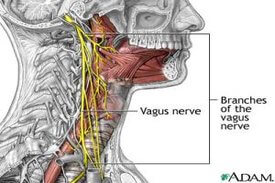>
In a New York Times health issue, there is an interesting article about current research being done on a medical device. This device physically goes around the vagus nerve and stimulates it. The vagus nerve is a part of the nervous system. When it is stimulated it turns on the parasympathetic nervous system. This is the part of our nervous system which is responsible for all things restorative including our healing, repair, and immune systems.
Researchers were initially surprised to find out that one can promote healing in this way. Yogi’s, on the other hand, have been working with this for centuries. It turns out that deep breathing stimulates the vagus nerve. This, in turn, promotes proper sleep and good health. The yogic science of pranayama works with this fact to not only reduce anxiety and promote well being but to actually heal conditions. In my yoga therapy practice, I regularly teach pranayamas for a wide range of conditions and I’m often questioned about why and how breathing can make problems better.
Of course, we will never have as much funding for breath work as we might have for a medical device but I think it’s great for yoga therapy to be able to make these connections to current research. Maybe when we see the price for these devices we will be more likely to take the cost-effective route of visiting a Yoga Therapist for some breath instruction.
Brandt
Brandt talks about common questions applicants have about the Breathing Deeply Yoga Therapy Program. Tune in to get the full program details.
Friends in Yoga, The way we perceive the world is a curious thing. Is it on fire or getting better? Are we facing our challenges or shying away from them? Are we functioning from the present or some altered reality based on past experiences? The teachings tell us that reality is ultimately timeless. The vibration […]
There’s no doubt that yoga is gaining popularity, but you may be asking yourself, what is the most popular type of yoga? Where is each type most popular in the U.S. and around the world? And for those who are interested in trying it themselves, how can you practice these styles of yoga safely? For […]
Friends in Yoga, Sitting on a cushion, taking a yoga class, chanting a mantra before your morning coffee…no one would call these radical acts. They are small choices that we make to better ourselves. The motivation to practice often takes form by our desire to be healthier, to be more focused, to connect with our […]